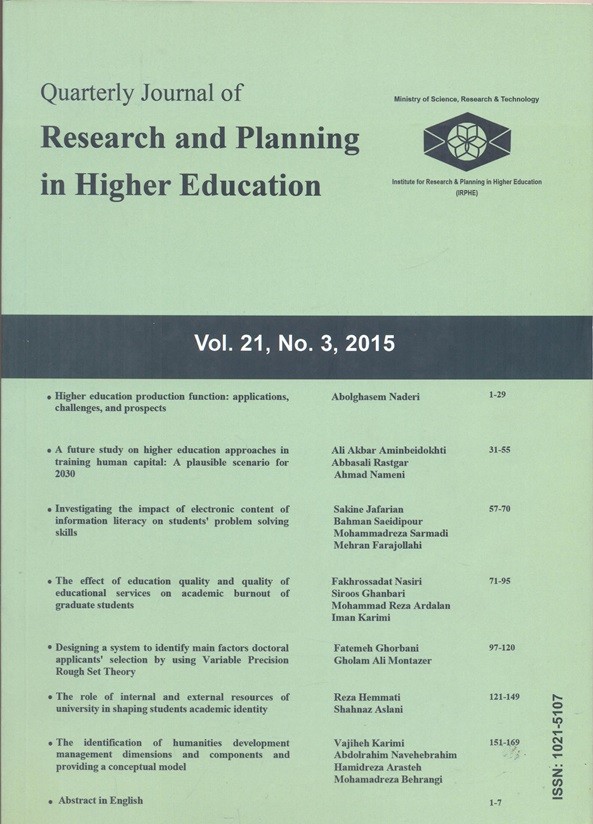A future study on higher education approaches in training human capital: A plausible scenario for 2030
Authors
1 Associate Professor,Faculty of Psychology and Educational Science, Semnan University
2 Associate Professor, Faculty of Economy and Management, Semnan University
3 Doctoral Students, Educational Management, Semnan University
Abstract
The purpose of this study was to identify key human capital competencies required in horizon 2030, and the necessary changes in educational approaches to meet its needs. This study is a qualitative type in the field of future studies, using scenario techniques, content analysis and trend analysis by applying Rieckmann approach. In this study, the faculty members of management departments in Tehran's State Universities and provincial capitals were chosen as experts. Expert's opinions about research questions were investigated via a questionnaire. Sup- scenarios based on analysis of the responses received from the participants, and the final scenario, according to interviews, were developed and validated. Under a dominant scenario, the human capital should be equipped by a series of other key competencies in 2030. The most important competencies were as follows: Superior thinking (thinking is characterized by dominant or recessive rather than neutral thoughts), high power on diagnosing problems accurately, and high power communication and teamwork in a Meta organizational- aspects. Furthermore, it was found that the development of this competency (at a possible extent) in the majority of educated capitals is vital in their development (at an excellent extent) in the elites. Regardless of the need for reform and changes in the contents and structure, universities can use some educational approaches, in order to provide much needed competencies for future generations.
Keywords
2. Arasteh, H.R. (2003). The role of higher education in Iran development statement for 1404. Rahiaft, 14(31), 33-41(in Persian).
3. Blass, E., Jasman, A., & Shelley, S. (2010). Visioning 2035: The future of the higher education sector in the UK. Futures, 42, 445-453.
4. Board of Engineers Malaysia (2012). List of accredited engineering. Retrieved from http://www.bem.org.my/v3/listofaccreditedprogrammes. html.
5. Danaiefard, H., Alvani, S. M., & Azar, A. (2013). The qualitative research methodology in management: A holistic view. Saffar- Eshraghi Press, Tehran (in Persian).
6. Douglass, J. A. (2010). Creating a culture of aspiration: Higher education, human capital and social change. Procedia Social and Behavioral Sciences, 2, 6981-6995 (in Persian).
7. Farasatkhah, M. (2008). Future thinking about quality of higher education of Iran. An excracted model from grounded theory. Quarterly Journal of Research and Planning in Higher Education, 50, 66-95 (in Persian).
8. Gil-Galván, R., & Gil-Galván, F. J. (2013). How to use professional and life projects to guide university students towards optimal professional development. Procedia Social and Behavioral Sciences, 93, 1901-1905.
9. Khamenehiy, S. A. (leader of Iran) (2012). The speeches in: Memorial ceremony of the late greate leader of Iran (2012), meeting with government members (2013), meeting with the guests of Islamic unity conference (2013), and meeting with the teachers of Fars state (2009). The respected leader`s office archive (in Persian).
10. Mahmoodi, B. (2006). Introducing future study and its methods. Sterategic Research Center of Expediency Council. Report No 20-85-2-4 (in Persian).
11. Moghiseh, R., Momeni Zahed, M., Maghrooni, M., & Yousefi, S. (2013). Thinking model and strategic look for future in the mind of Imam Khamenehiy. Second National Conference of Future Study, Tehran (in Persian).
12. National Academy of Engineering (2005). Educating the engineer of 2020: Adapting engineering education to the new century. Washington DC, the National Academies Press.
13. Noohi, A., Abbaszadeh, A., Maddah, S.S., & Borhani, F. (2012). Participatory learning experiences in problem oriented teaching: A qualitative study. Quarterly Journal of Qualitative Researches in Health Sciences, 4, 255-567 (in Persian).
14. Phang, F. A., Yusof, K.M., & Samah, N. A. (2013). Preliminary study to determine the current status of engineering programmes at the Malaysian Public Universities. Procedia Social and Behavioral Sciences, 102, 577-586.
15. Rieckmann, M. (2012). Future-oriented higher education: Which key competencies should be fostered through university teaching and learning?. Futures, 44,127-135.
16. Sessa, C., & Ricci, A. (2014). The world in 2050 and the new welfare scenario. Futures, 58, 77-90.
17. Son, H. (2013). Alternative future scenarios for South Korea in 2030. Futures, 52, 27-41.
18. The Royal Academy of Engineering (2007). Educating engineers for the 21st century. London: The Royal Academy of Engineering.
19. Tiwari, G., & Yeravdekar, V.R. (2014). Internationalization of higher education and its impact on enhancing corporate competitiveness and comparative skill formation. Procedia Social and Behavioral Sciences, 157, 203-209.
20. UNESCO (1972). Convention concerning the protection of the world cultural and natural heritage.
21. United Nations Organization (2004). World population to 2300. Department of Economic and Social Affairs- Population Division.
 Quarterly Journal of Research and Planning in Higher Education
Quarterly Journal of Research and Planning in Higher Education
